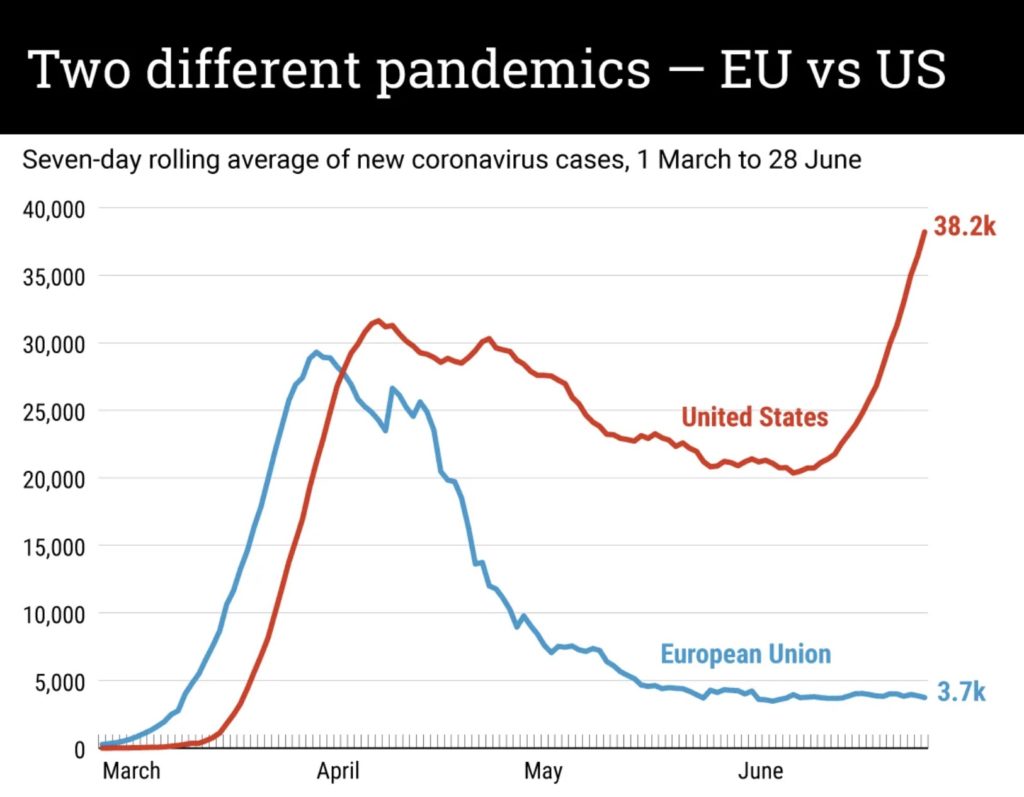America Dances (part 2): American Exceptionalism

Image courtesy of NASA Earth Observatory; public domain
America Dances (part 2): American Exceptionalism
If pandemic control were an Olympic event, the US would lose in the quarterfinals, if it earned the right to compete at all.
As I said in my previous post, the US is experiencing a lot of regional variation with the epidemic. But taken as a whole, our country’s dance is terrible compared to Western Europe and some East Asian countries. In the graph below, you see the number of daily confirmed new COVID-19 cases reported as a seven-day average for the United States versus the European Union. The numbers are already shocking to me, yet this graph is out of date—currently the US is averaging closer to 50,000 new cases per day. The EU has more people than the US (about 440 million versus about 330 million) but less than one-tenth as many new coronavirus cases.
 Data Source: Johns Hopkins University. Figure from GZeroMedia
Data Source: Johns Hopkins University. Figure from GZeroMedia
For a specific example, consider the United Kingdom which had a really rough start to the pandemic this winter. According to the World Health Organization, on July 5 the UK reported 624 new cases. The United States clocked in 51,933, almost a hundred times more. (Population difference is only five times more.)
How can this be?
Why the huge difference between the US and Western Europe? That’s a complex question with many answers. Here are a few.
The transition from hammer to dance: The graph shows a stark divergence between growth in new cases in US vs EU in late June. It illustrates another important distinction in early May. The US phased out of the hammer and into the dance when the virus was still spreading readily within some of our communities. Daily case counts had peaked but not really fallen much when re-opening began. The EU, on the other hand, kept the hammer down for longer, ultimately reducing the new case count to less than 5,000 per day for the entire continent. When they reopened, they had virus flareups whereas the US had a pretty steady blaze still burning.
Testing and Contact Tracing: The EU didn’t eradicate the virus. So why isn’t the number of cases growing exponentially each time a flareup occurs? Because they use testing, contract tracing, and quarantine to extinguish the flareups.
Widespread testing is the first step. You can’t put out a fire if nobody is aware of it. By testing enough people you can identify most new viral infections and contain them. How much testing is enough testing? When the percent of tests that come back positive is low, say, less than 5%. That shows you are probably not missing many new cases. In Arizona last week the positive test rate was 25%; in Florida, it was 18%. Not enough tests!
Whenever a person tests positive for the coronavirus, contact tracers from the public health department are supposed to quickly identify any other people the patient may have infected. Those people are notified and ordered to get tested, to watch for symptoms, and possibly to quarantine for two weeks. In some countries, such quarantines are enforced by law with severe penalties for violations, or the state provides isolation housing. Done well, this process of testing, contact tracing, and quarantine will control the epidemic.
The US is trying to do this, county by county. Thousands of people have been trained and hired as contact tracers across the country. But unlike South Korea, for example, we aren’t using technology to track people and figure out who has been exposed to each newly diagnosed case. Our contact tracers must use old-fashioned techniques, primarily phone calls and interviews. This works if everybody answers their phone and does their best to honestly tell a stranger all their movements, activities, and social interactions of the past week. Guess what: mistrustful Americans are not cooperating very well. Even if we had perfect compliance, this kind of contact tracing is labor-intensive. It works as long as the number of new cases is small. But when a county is surging with hundreds of new cases in a day (or even a few dozen for a small county), the contact tracing staff is overwhelmed. If contacts can’t be found and notified within a day, or two at the most, then the virus will spread. Finally, even when contacts are notified in a timely fashion, in the US self-quarantine is voluntary, unsupported, and unsupervised. Frequently, it fails.
A happier dance
I have repeatedly emphasized that the #1 goal of our dance in the US must be to keep the number of seriously ill people within the capacity of our health care system. This allows COVID and non-COVID patients alike to get the best care possible, and minimize deaths. As I said in my previous post, today in much of the US we are achieving this goal but some regions especially in the south and west are swiftly striding toward failure.
What Europe shows us is that a more ambitious public health goal is possible to achieve. In countries that beat back the virus and then “dance” to maintain a low prevalence, they not only have space in their ICUs, they also can relax their social distancing. For example, despite a big initial wave of COVID, Iceland has largely eliminated the virus from the whole country. As a result, it’s safe for people to gather in bars, dine in restaurants, and visit popular sites—without masks, even. Life has largely returned to normal except for the usual summer influx of tourists, which is about to resume from a select list of countries (with testing upon arrival). As of July 6, that list notably does NOT include visitors from the US. Maintaining low prevalence is possible for countries that aren’t islands, too. France has recovered from a bad start to the pandemic and public life in Paris has resumed without a surge in new infections.
Did America get it wrong?
In my coronavirus blog I have repeatedly emphasized that science doesn’t dictate policy; values matter in decision making. “Wrong” is a value statement. In my next blog post (part 3 of “America Dances”) I’ll talk about the values, costs, and benefits that factored into the big difference between where we are now in the US versus the EU. Should we change course, and is a course correction possible?
NEXT: America Dances Part 3: How did we get here?
{My blog post from May 9 on contact tracing.}
Amy Rogers, MD, PhD, is a Harvard-educated scientist, novelist, journalist, and educator. Learn more about Amy’s science thriller novels, or download a free ebook on the scientific backstory of SARS-CoV-2 and emerging infections, at AmyRogers.com.
Sign up for my email list
Share this:



0 Comments